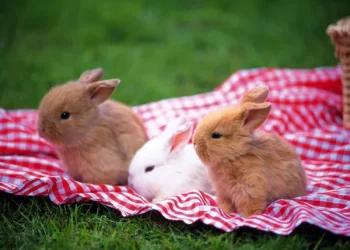Rabbits are often considered one of the more enigmatic pets, known for their unique behaviors and needs. Among these, their sleeping habits are of particular interest, as they reveal much about their health, environment, and overall well-being. Understanding how rabbits sleep is crucial for providing them with a suitable habitat and ensuring their comfort and health. In this comprehensive article, we will explore the various aspects of rabbit sleep, including their natural sleep patterns, preferences, and the factors that influence their sleep quality.
The Natural Sleep Patterns of Rabbits
Rabbits have distinct sleep patterns that differ significantly from those of humans and many other animals. To appreciate how domestic rabbits sleep, it’s essential first to understand their natural sleep behaviors in the wild.
Crepuscular Sleep Schedule
Rabbits are crepuscular animals, which means they are most active during the dawn and dusk hours. This behavior is an evolutionary adaptation that helps them avoid predators. In the wild, rabbits use the early morning and late evening light to forage and engage in social activities while resting during the heat of the day and the cover of night.
Active Periods: During these times, wild rabbits will typically be foraging for food, grooming, and interacting with other rabbits. They are also alert to potential threats and will use their keen senses to detect predators.
Resting Periods: Rabbits will spend the middle of the day and late at night resting in burrows or hiding spots. This is their primary period of inactivity, during which they conserve energy and avoid predators.
Polyphasic Sleep
Rabbits exhibit polyphasic sleep, meaning they sleep in multiple short periods throughout the day rather than in one long stretch. This behavior is quite different from the monophasic sleep patterns of humans, who typically sleep in a single, continuous block of time.
Short Naps: Wild rabbits will take numerous short naps throughout the day and night, each lasting anywhere from a few minutes to a couple of hours. These naps are often light and can be interrupted easily if the rabbit senses danger.
Deep Sleep: While rabbits do experience deeper, more restful sleep, these periods are relatively brief and interspersed with lighter, more alert phases.
Sleeping Preferences in Domestic Rabbits
Domestic rabbits, while maintaining some of their wild instincts, also adapt their sleep behaviors to their home environment. Their sleeping preferences can provide valuable insights into their comfort and health.
Sleeping Positions
Rabbits have several preferred sleeping positions, each reflecting their level of comfort and security:
Loaf Position: This is the most common sleeping position where the rabbit tucks its legs under its body and rests its head on its front paws. This position is a sign that the rabbit feels safe and secure in its environment.
Side Sleeping: Some rabbits may sleep on their sides with their legs splayed out. This position indicates a high level of relaxation and trust, as the rabbit is exposing its vulnerable belly.
Tucked Head: Rabbits may also sleep with their head tucked into their body or under their paws. This position helps them conserve heat and can be a sign of comfort or a response to cooler temperatures.
Stretched Out: Occasionally, rabbits will sleep stretched out with their body fully extended. This position can indicate that the rabbit is very comfortable and feels completely secure in its surroundings.
Preferred Sleeping Areas
Rabbits are known to seek out specific areas for sleeping, which often reflect their need for safety and comfort:
Enclosed Spaces: Rabbits prefer sleeping in enclosed or semi-enclosed spaces where they feel protected from potential threats. This can include designated rabbit beds, tunnels, or hideouts.
Soft Surfaces: A rabbit’s sleep area should ideally be soft and comfortable. Many rabbits enjoy resting on soft bedding, such as hay, fleece, or specially designed rabbit beds. Hard or uncomfortable surfaces can disrupt their sleep and lead to stress.
Temperature Regulation: Rabbits are sensitive to temperature extremes. They prefer environments that are neither too hot nor too cold. Providing a temperature-controlled environment with access to both warm and cool areas helps ensure that rabbits can sleep comfortably.
Factors Influencing Rabbit Sleep Quality
Several factors can impact the quality of a rabbit’s sleep, affecting their overall well-being and behavior.
Environmental Enrichment
Environmental enrichment plays a crucial role in a rabbit’s ability to rest well. A stimulating environment that mimics natural conditions can help reduce stress and improve sleep quality.
Space: Adequate space for movement is essential. A cramped or overly confined area can lead to stress and affect sleep patterns. Rabbits need room to stretch out, hop around, and explore.
Toys and Hiding Spots: Providing toys, tunnels, and hiding spots helps keep rabbits engaged and reduces stress. Enrichment activities can promote better sleep by keeping rabbits mentally stimulated and reducing anxiety.
Health and Wellness
Health issues can significantly impact a rabbit’s sleep patterns and overall comfort.
Pain and Discomfort: Conditions such as arthritis, dental problems, or gastrointestinal issues can cause discomfort and disrupt sleep. Regular veterinary check-ups and prompt treatment of health issues are essential for maintaining good sleep quality.
Stress and Anxiety: Environmental changes, loud noises, or the presence of other pets can cause stress and interfere with a rabbit’s sleep. Ensuring a calm and stable environment helps rabbits feel secure and promotes better sleep.
See Also: Do Bananas Help Rabbits Gain Weight?
Diet: A balanced diet affects a rabbit’s overall health and sleep. Providing a diet rich in hay, fresh vegetables, and clean water supports healthy digestion and can prevent gastrointestinal issues that might disrupt sleep.
Age and Activity Levels
Age and activity levels also influence how rabbits sleep.
Young Rabbits: Baby rabbits and young rabbits tend to sleep more than adults. They need extra rest to support their growth and development.
Older Rabbits: As rabbits age, they may experience changes in sleep patterns and require more rest. Older rabbits might also be more sensitive to changes in their environment or health issues.
Practical Tips for Enhancing Your Rabbit’s Sleep Environment
Creating an optimal sleep environment for your rabbit involves several practical steps:
Provide a Comfortable Sleeping Area
Bedding: Use soft, absorbent bedding that is safe and comfortable for your rabbit. Avoid using bedding that can cause respiratory issues, such as cedar or pine shavings.
Hideouts: Offer a variety of hideouts and enclosed spaces where your rabbit can retreat and feel secure. Ensure these spaces are easy to access and clean.
Maintain a Suitable Temperature
Temperature Control: Keep the rabbit’s living area within a comfortable temperature range (60-70°F or 15-21°C). Avoid placing the enclosure in direct sunlight or drafty areas.
Ventilation: Ensure proper ventilation to avoid overheating or humidity buildup, which can affect your rabbit’s comfort and sleep.
Reduce Stress and Disruptions
Quiet Environment: Minimize noise and disruptions in your rabbit’s environment. Create a calm space where your rabbit can relax without sudden disturbances.
Routine: Maintain a consistent routine for feeding, cleaning, and handling. Rabbits thrive on routine, and consistency can help reduce stress and promote better sleep.
Monitor Health
Regular Check-ups: Schedule regular veterinary visits to monitor your rabbit’s health and address any issues that may impact their sleep.
Behavioral Observation: Pay attention to changes in your rabbit’s behavior, such as changes in sleep patterns, appetite, or activity levels, which may indicate health concerns.
Conclusion
In conclusion, understanding how rabbits like to sleep involves recognizing their natural sleep patterns, preferences, and the factors that influence their sleep quality. Rabbits are crepuscular animals with polyphasic sleep patterns, taking multiple short naps throughout the day and night. They prefer soft, enclosed spaces for sleeping and can exhibit various positions that reflect their comfort and security.
Factors such as environmental enrichment, health, and age play a significant role in determining a rabbit’s sleep quality. By providing a comfortable and stimulating environment, maintaining proper health care, and minimizing stress, you can ensure that your rabbit enjoys restful and restorative sleep.
Ultimately, the key to a happy and healthy rabbit is understanding their unique needs and behaviors. By paying attention to their sleep habits and making informed adjustments, you can create an environment that supports their well-being and enhances their overall quality of life.
Related Topics:



























